HugginFace
[TOC]
HugginFace
By:weimenghua
Date:2023.08.13
Description:
参考资料
1. 基本介绍
Hugging Face是一个知名的开源社区和公司,专注于自然语言处理(NLP)和机器学习(ML)领域。
Huggingface 模块
- Models(模型),各种处理 CV 和 NLP 等任务的模型
- Datasets(数据集)
- Spaces(空间),社区空间分享
- Docs(文档),包括各种模型算法等说明使用文档
- Solutions(解决方案)
- Pricing(报价)
2. Models(模型)

Huggingface 模型分类
- Computer Vision(计算机视觉任务):包括lmage Classification(图像分类),lmage Segmentation(图像分割)、zero-Shot lmage Classification(零样本图像分类)、lmage-to-Image(图像到图像的任务)、Unconditional lmage Generation(无条件图像生成)、Object Detection(目标检测)、Video Classification(视频分类)、Depth Estimation(深度估计,估计拍摄者距离图像各处的距离)
- Natural Language Processing(自然语言处理):包括Translation(机器翻译)、Fill-Mask(填充掩码,预测句子中被遮掩的词)、Token Classification(词分类)、Sentence Similarity(句子相似度)、Question Answering(问答系统),Summarization(总结,缩句)、Zero-Shot Classification (零样本分类)、Text Classification(文本分类)、Text2Text(文本到文本的生成)、Text Generation(文本生成)、Conversational(聊天)、Table Question Answer(表问答,1.预测表格中被遮掩单词2.数字推理,判断句子是否被表格数据支持)
- Audio(语音):Automatic Speech Recognition(语音识别)、Audio Classification(语音分类)、Text-to-Speech(文本到语音的生成)、Audio-to-Audio(语音到语音的生成)、Voice Activity Detection(声音检测、检测识别出需要的声音部分)
- Multimodal(多模态):Feature Extraction(特征提取)、Text-to-Image(文本到图像)、Visual Question Answering(视觉问答)、Image2Text(图像到文本)、Document Question Answering(文档问答)
- Tabular(表格):Tabular Classification(表分类)、Tabular Regression(表回归)
- Reinforcement Learning(强化学习):Reinforcement Learning(强化学习)、Robotics(机器人)
3. Datasets(数据集)
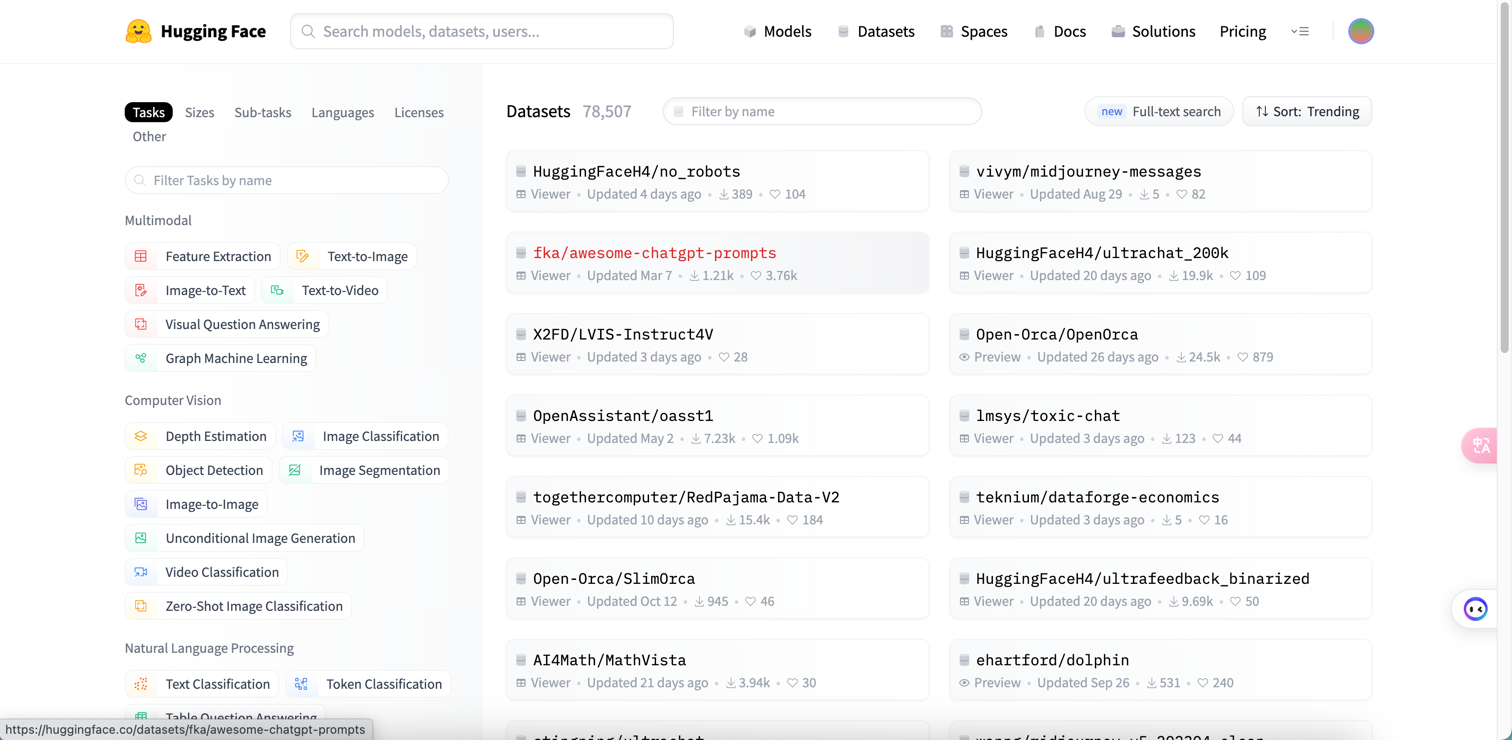
Huggingface 使用
- 克隆模型仓库
克隆模型仓库 https
git lfs install
git clone https://huggingface.co/weimmmhhh/wei-model-001
克隆模型仓库 ssh
git lfs install
git clone git@hf.co:weimmmhhh/wei-model-001
只下载模型实现
GIT_LFS_SKIP_SMUDGE=1 git clone https://huggingface.co/THUDM/chatglm-6b
- 训练、部署
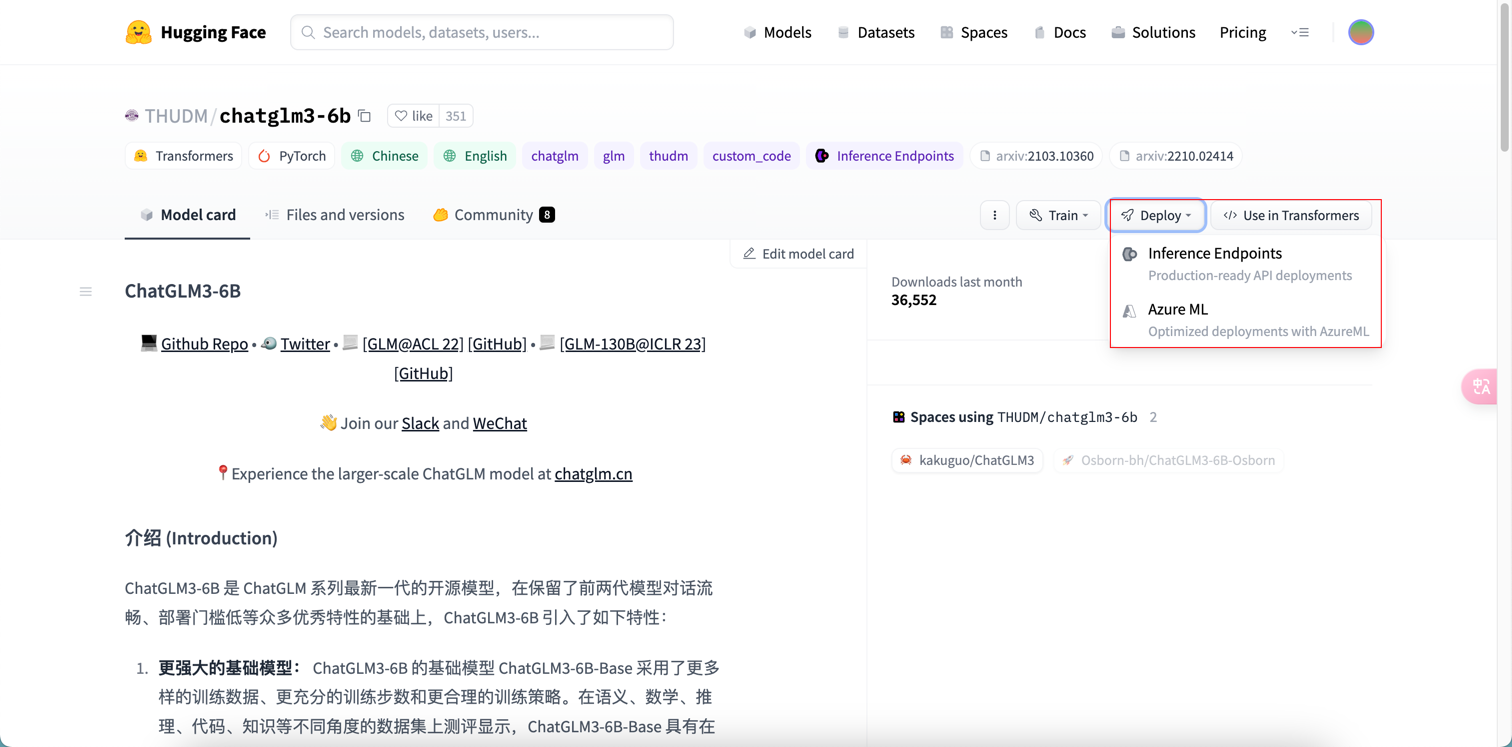
- 创建应用
Space SDK 选择 Gradio,详情可查看 Gradio 帮助文档
git clone git@hf.co:spaces/weimmmhhh/wei-space-002
cd wei-space-002
vim app.py 添加以下内容:
import gradio as gr
def greet(name):
return "Hello " + name + "!!"
iface = gr.Interface(fn=greet, inputs="text", outputs="text")
iface.launch()
git add app.py
git commit -m "Add application file"
git push
- 推送后即自动运行容器,进入应用页面可使用应用功能
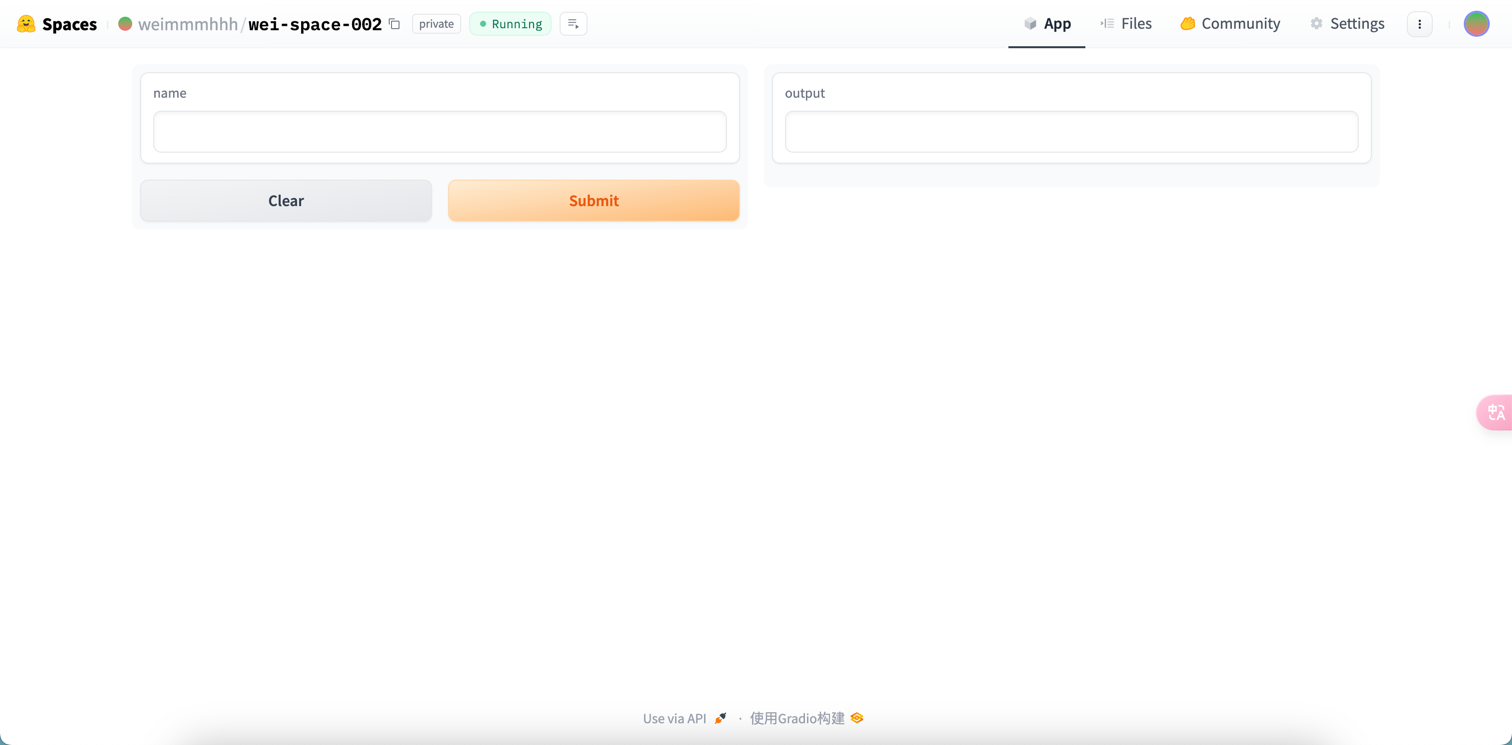
4. Spaces(分享空间)
Hugging Face Spaces 提供了一种简单的方法,可以直接在您的个人资料或组织的个人资料中托管 ML 演示应用程序。这使您可以创建自己的 ML 投资组合,在会议上或向利益相关者展示您的项目,并与 ML 生态系统中的其他人协作。
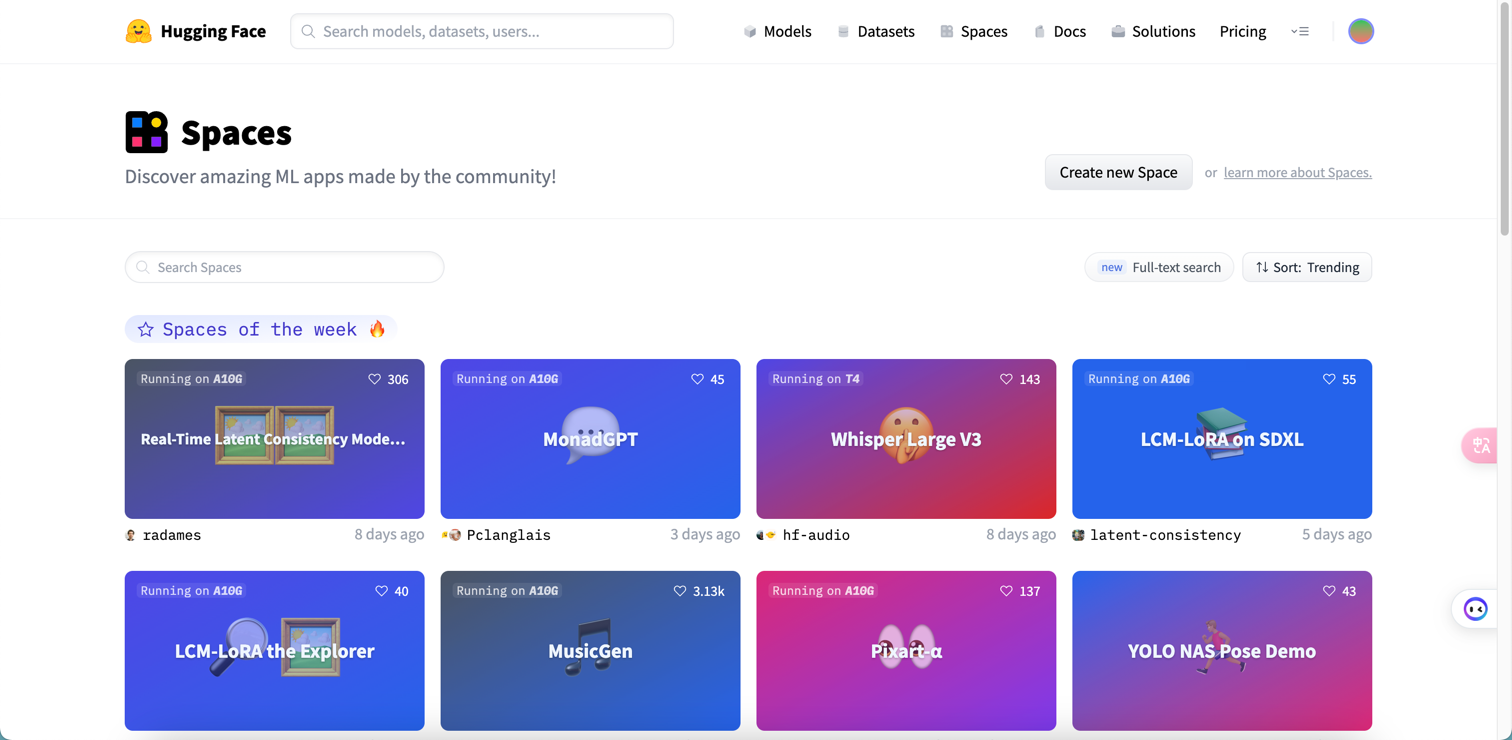
Space SDK
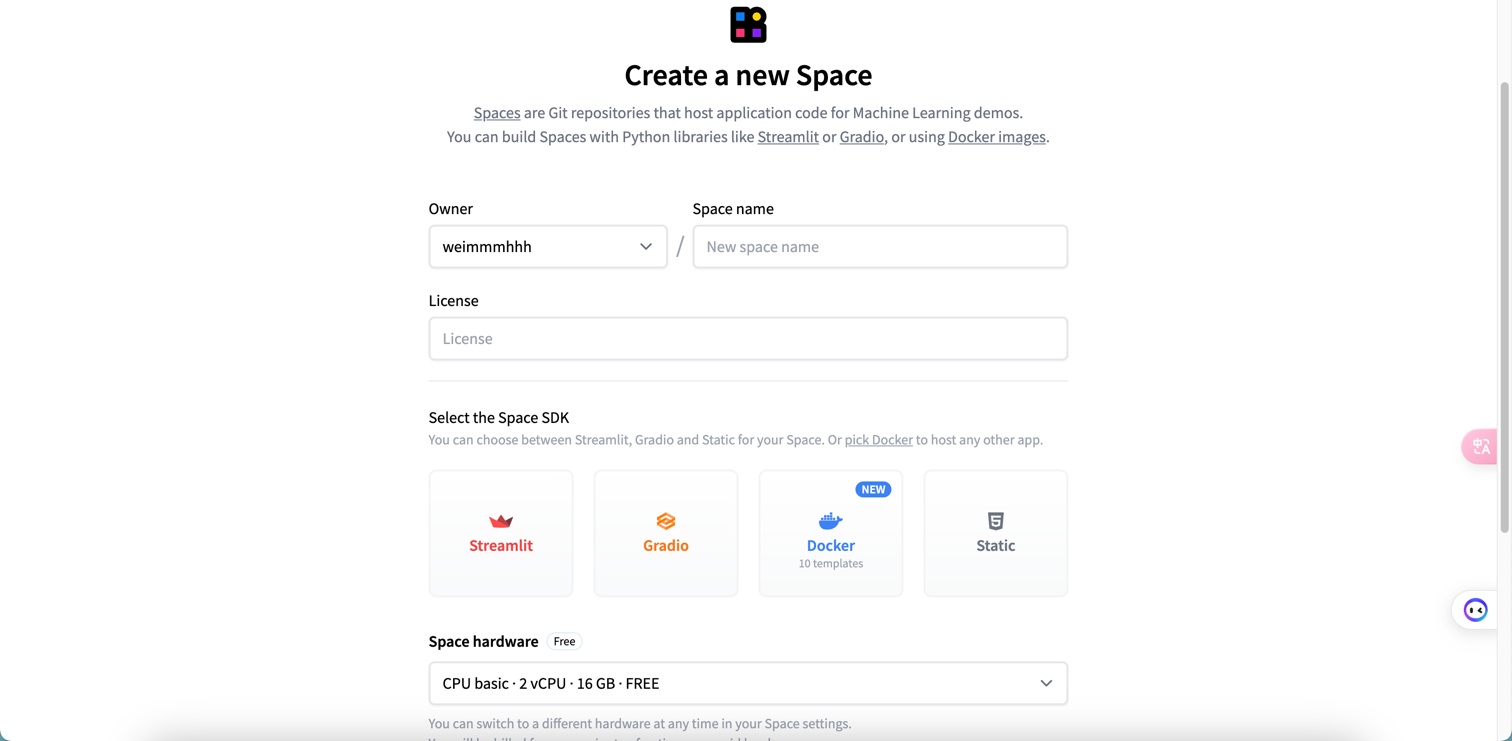
Streamlit
Streamlit是个 Python 库,偏向于可视化数据展示,帮助文档, Streamlit 例子 1 、Streamlit 例子 2。
例子
git lfs install
git clone https://huggingface.co/spaces/weimmmhhh/wei-space-streamlit
cd wei-space-streamlit && vim requirements.txt
transformers
torch
vim app.py
import streamlit as st
from transformers import pipeline
from PIL import Image
pipeline = pipeline(task="image-classification", model="julien-c/hotdog-not-hotdog")
st.title("Hot Dog? Or Not?")
file_name = st.file_uploader("Upload a hot dog candidate image")
if file_name is not None:
col1, col2 = st.columns(2)
image = Image.open(file_name)
col1.image(image, use_column_width=True)
predictions = pipeline(image)
col2.header("Probabilities")
for p in predictions:
col2.subheader(f"{ p['label'] }: { round(p['score'] * 100, 1)}%")
推送代码
git add app.py
git commit -m "Add application file"
git push
运行程序
streamlit run app.py
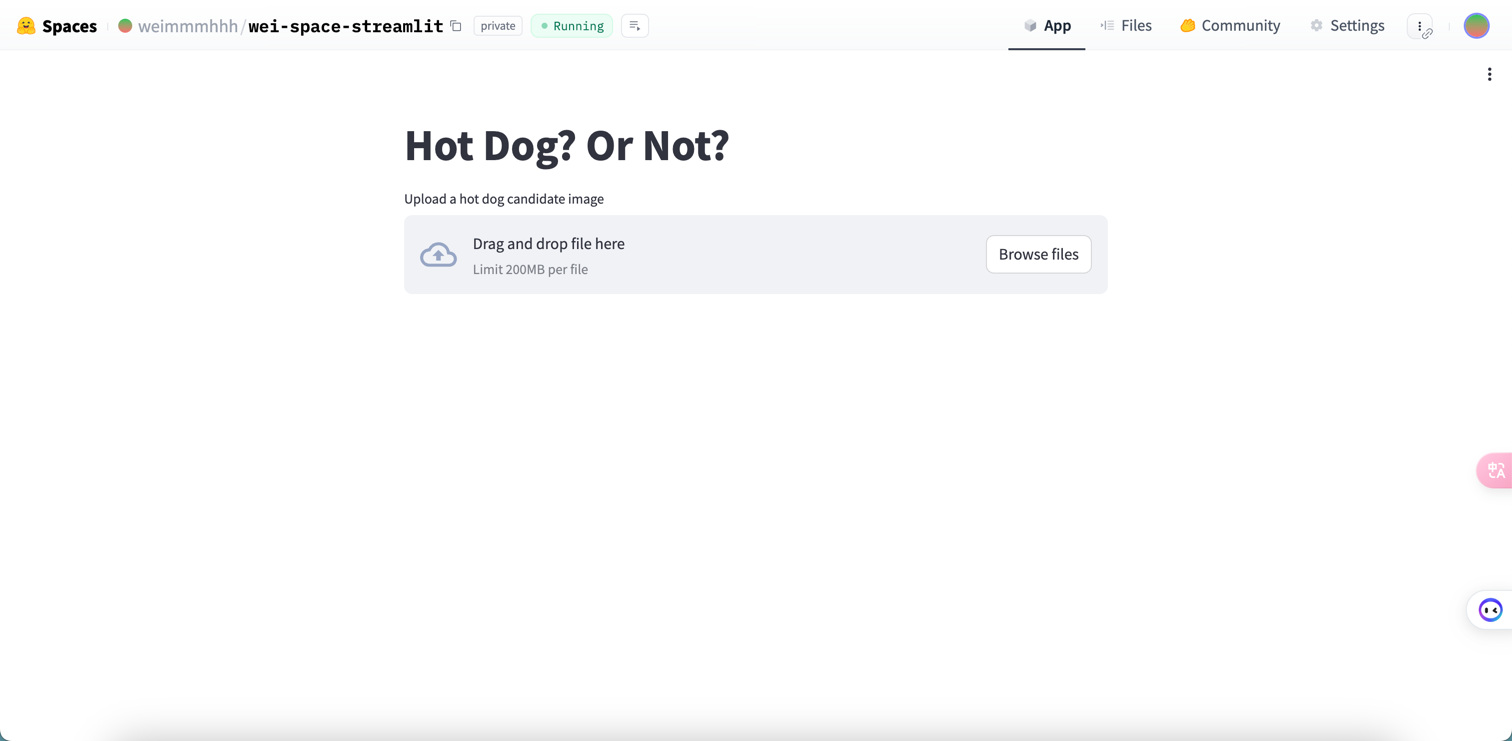
Gradio
Gradio 是一个用于构建交互式界面的库,能够轻松地为的深度学习模型创建Web应用程序。Gradio 提供了一个简单而强大的API,可以将模型与用户界面组件(如文本框、滑块、图像上传器等)相连接,从而实现模型的实时推理和可视化,参考 Gradio 例子1、Gradio 例子2。
克隆代码
git clone git@hf.co:spaces/weimmmhhh/wei-space-gradio
cd wei-space-gradio && vim app.py
import gradio as gr
def greet(name):
return "Hello " + name + "!!"
iface = gr.Interface(fn=greet, inputs="text", outputs="text")
iface.launch()
推送代码
git add app.py
git commit -m "Add application file"
git push
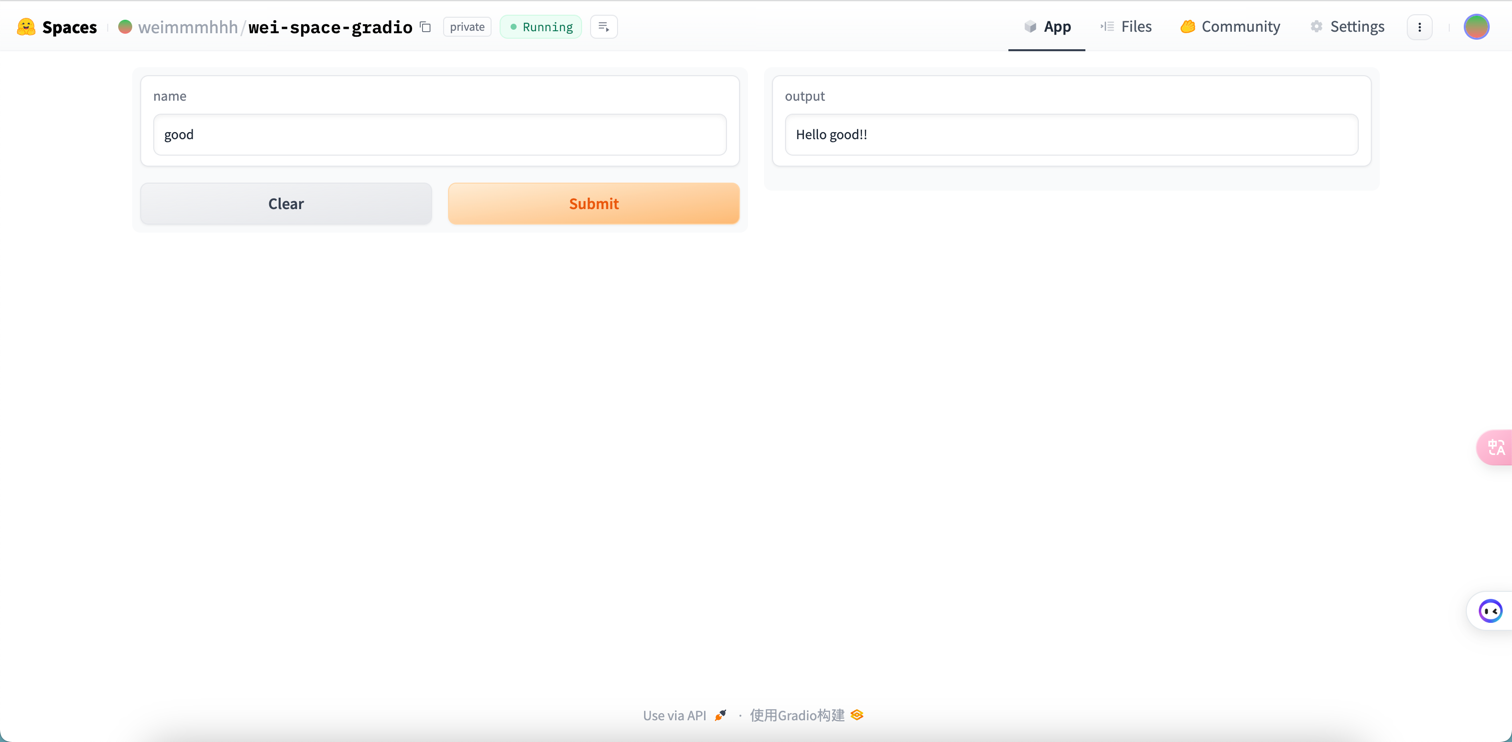
import gradio as gr
def greet(name, is_morning, temperature):
salutation = "Good morning" if is_morning else "Good evening"
greeting = f"{salutation} {name}. It is {temperature} degrees today"
celsius = (temperature - 32) * 5 / 9
return greeting, round(celsius, 2)
demo = gr.Interface(
fn=greet,
inputs=["text", "checkbox", gr.Slider(0, 100)],
outputs=["text", "number"],
)
demo.launch()
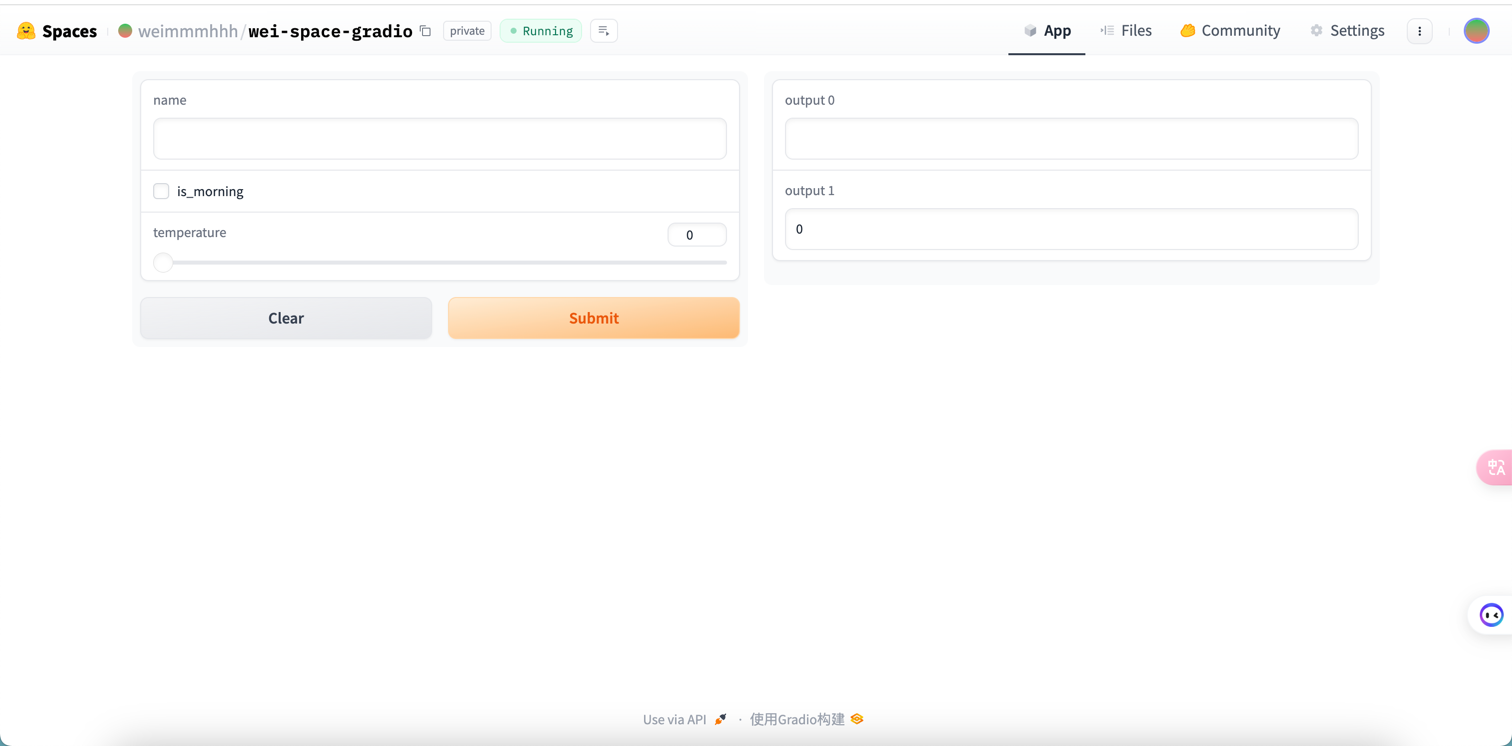
Docker
vim requirements.txt
fastapi==0.74.*
requests==2.27.*
sentencepiece==0.1.*
torch==1.11.*
transformers==4.*
uvicorn[standard]==0.17.*
vim app.py
from fastapi import FastAPI
app = FastAPI()
@app.get("/")
def read_root():
return {"Hello": "World!"}
vim Dockerfile
FROM python:3.9
WORKDIR /code
COPY ./requirements.txt /code/requirements.txt
RUN pip install --no-cache-dir --upgrade -r /code/requirements.txt
COPY . .
CMD ["uvicorn", "main:app", "--host", "0.0.0.0", "--port", "7860"]
推送代码
git add Dockerfile
git commit -m "Add application file"
git push

Static
新建 Space 后默认生成 index.html 和 style.css
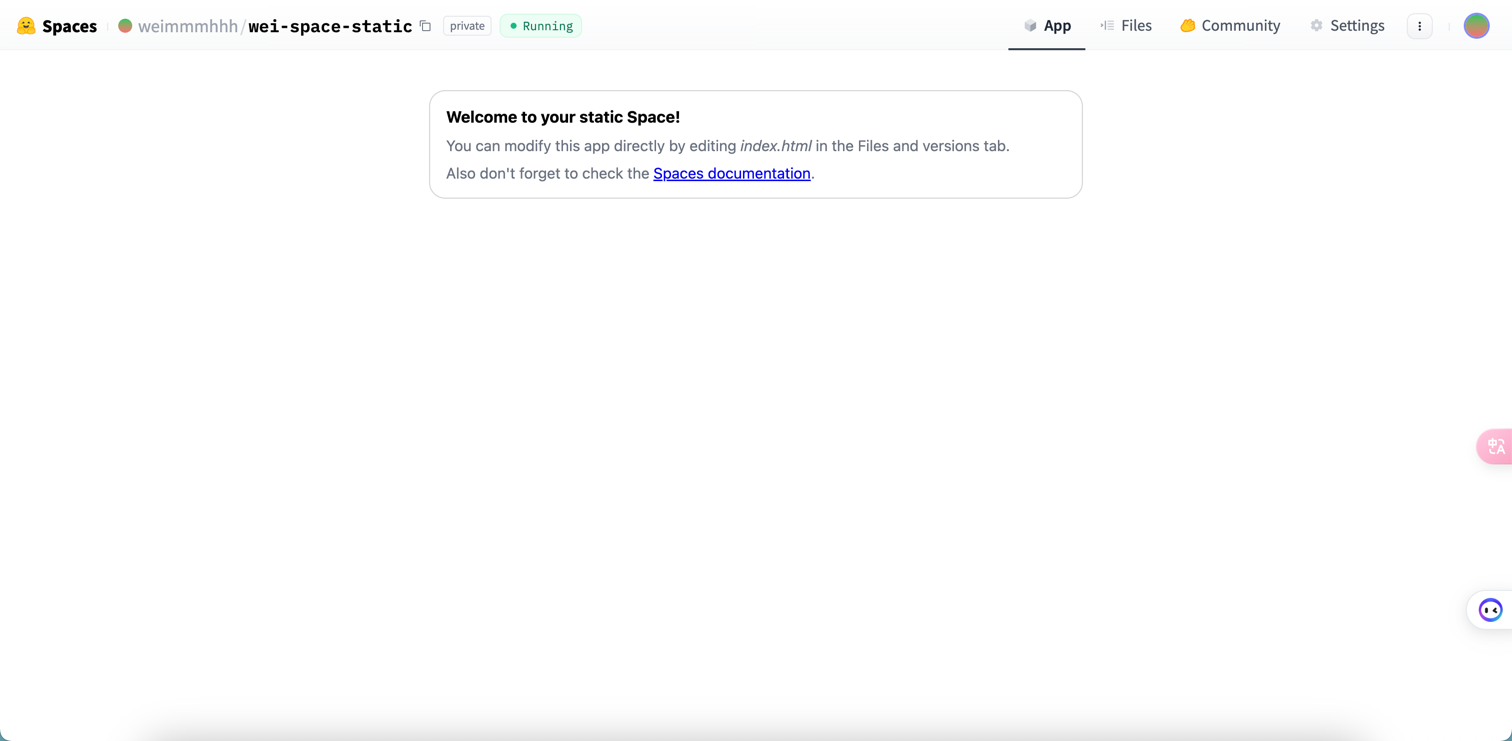
5. AutoTrain(自动训练)
AutoTrain 是一个用于自动化训练的库,旨在简化模型训练的过程。它提供了一种简单的方法来定义和训练深度学习模型,自动处理数据加载、批处理、优化器、损失函数等训练过程中的细节。
Huggingface AutoTrain,入口:Solutions > AutoTrain / 模型详情的 Train。
6. 推理
- 推理 API
推理(Inference) API 是为推理组件提供动力的引擎。通过一个简单的 HTTP 请求,你可以加载 hub 上的任何模型,并在几秒钟内用它预测你的数据,只需要你提供模型的 URL 和一个有效的 hub token。注:前提是使用Hugging Face自己的一套逻辑训练的模型,参考文档:推理组件。
用一行代码加载 xlm-roberta-base 模型 并进行数据预测的案例:
curl https://api-inference.huggingface.co/models/xlm-roberta-base \
-X POST \
-d '{"inputs": "The answer to the universe is <mask>."}' \
-H "Authorization: Bearer HF_TOKEN"
- 推理 Endpoints
7. 知识碎片
著名模型
HG DOI
Huggingface 提供了为您的模型或数据集生成 DOI 的可能性。DOI (数字对象标识符)是唯一标识数字对象的字符串,从文章到图形,包括数据集和模型。DOI 与对象元数据绑定,包括对象的 URL、版本、创建日期、描述等。它们是研究和学术界普遍接受的数字资源参考; 它们类似于一本书的 ISBN。
Hugging Face生态系统还包括用于其他任务的库,例如数据集处理(“Datasets”),模型评估(“Evaluate”),模拟(“Simulate”),以及机器学习演示(“Gradio”)。
TPU(Tensor Processing Unit, 张量处理器)就是谷歌专门为加速深层神经网络运算能力而研发的一款芯片
NPU (NeuralNetworks Process Units)神经网络处理单元。NPU工作原理是在电路层模拟人类神经元和突触,并且用深度学习指令集直接处理大规模的神经元和突触,一条指令完成一组神经元的处理。相比于CPU和GPU,NPU通过突出权重实现存储和计算一体化,从而提高运行效率。
FPGA(Field-Programmable Gate Array)称为现场可编程门阵列,用户可以根据自身的需求进行重复编程。与 CPU、GPU 相比,具有性能高、功耗低、可硬件编程的特点。
FPGA基本原理是在芯片内集成大量的数字电路基本门电路以及存储器,而用户可以通过烧入FPGA 配置文件来定义这些门电路以及存储器之间的连线。这种烧入不是一次性的,可重复编写定义,重复配置。